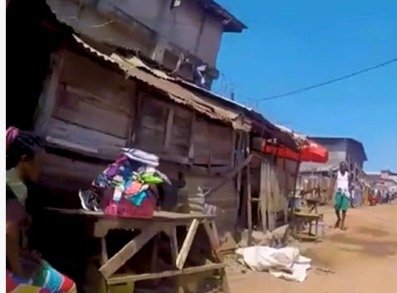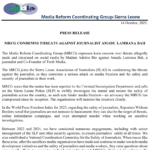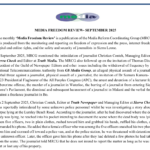By patricia.ngevao@awokonewspaper.sl (MRCG/ATJLF Fellow 2025)
Ibrahim Yambasu, a 32-year-old tailor, was just a child during Sierra Leone’s civil war from 1991-2002. Despite the passage of time, the trauma that his family experienced is still very much alive in his memory.
Sitting in his small shop in Kanikay, surrounded by fabric, amid the hum of his sewing machine, he reflects on the harsh realities of his past.
“The war destroyed everything,” he says. “My parents had to flee from Moyamba. They lost everything, our land, our home. They came to Freetown with nothing.”
His voice, tinged with the frustration of both his own generation and the youth of today, Ibrahim attributes the cause of the war to deep-seated issues of inequality and a failing system that offered little to young people.
“People were angry. The country was suffering, and some believed the only way to fix things was through war. But war doesn’t fix anything, it just makes life worse,” he said.
Today, as he tries to understand the state of his country, Ibrahim sees the same anger and frustration rising among the youth. “Look at our country. Young men have no jobs, and some are turning to crime. Even in Kanikay, you see it, boys joining gangs, fighting, doing drugs. It’s like they don’t care about life,” he said.
More than two decades have passed since the official end of war, but for many of the country’s youth, its ghosts continue to haunt them. In places like Kanikay, a densely populated area in the east end of the capital Freetown, the war’s effect can still be felt in the poverty, crime, and political disillusionment that plague the community.
For those who lived through the conflict and the generation born after the eleven years conflict ended, the scars remain an inescapable part of daily life
In July 2024, Kanikay was the site of a violent land dispute between residents and G. Tex Company, an importer of foodstuffs. The conflict, described as a “bloody land battle,” erupted when the company attempted to claim community land along the sea coast.
Youths vowed to sacrifice their lives to defend the land, citing a previous agreement with local police to prevent corporate encroachment and mitigate future flooding risks. However, the Sierra Leone Police (SLP) disregarded the agreement, triggering violent clashes.
Similarly, on August 10, 2022, Kanikay was one of the flashpoints of nationwide protests against economic hardship. The demonstrations quickly escalated into deadly clashes with security forces, resulting in multiple deaths and mass arrests.
In addition, authorities have since launched aggressive raids to dismantle drug dens and criminal hideouts in the area, but these interventions do little to address the root causes of youth frustration.
N’mah Bendu, 19, was born after the war. But for her, the effects of the conflict are unavoidable, largely due to the harrowing stories she heard from her family. Her uncle, who was forced to flee Kono during the war, frequently recounts the horrors they experienced, including long, grueling days of walking without food or water. N’mah describes an incident when her mother fell while running from the rebels; she still carries the scars from that moment to this day.
“My cousin was forced to fight for the rebels, and he’s never been the same,” She explains somberly. “Even today, he struggles to live a normal life. For some of us, the war never ended.”
Though N’mah wasn’t born before the conflict, its trauma echoes strongly in her family’s history. “Some people never recovered,” she says. “Families were broken. Many lost their homes and never got them back. The country never fully healed.”
Both Ibrahim and N’mah express a deep dissatisfaction with how justice was administered in the aftermath of the war. While the Special Court for Sierra Leone and the Truth and Reconciliation Commission (TRC) sought to address the crimes of the conflict, they believe that true justice never reached the most vulnerable and marginalized members of society.
Ibrahim, reflecting on the TRC and the Special Court’s work, questions its effectiveness. “Did it really change anything for poor people?” he asks. “Did it bring justice to those who suffered the most, the ones who lost their families, their homes with the women who were raped?”
N’mah, though unfamiliar with the term “transitional justice,” has a keen understanding of its absence in the post-war landscape. “Some victims never got justice. The government should support them more. They should also create better opportunities for young people, so that we don’t end up frustrated like those who started the war,” she says.
Ibrahim meanwhile, is more direct in his frustration. “Many victims of the war are still struggling. What about the women who were raped? What about the amputees begging on the streets? What has really changed for them?” he points out.
The two share a deep-seated fear: that Sierra Leone’s troubled past has not been fully addressed, and that as a result, the country could slip back into conflict. Both point to the persistent issues of poverty, corruption, and inadequate leadership that sparked the war as ongoing threats.
Ibrahim is blunt. “If you look at what caused the war, can you say those things are gone?” he asks, referring to the economic and political issues that led to the conflict.
N’mah concurs. “Most young people don’t really care about the past because they are too busy trying to survive. But the same frustrations are there. If we don’t understand what happened, we might repeat the same mistakes.”
They believe that a lack of education about the war contributes to the country’s fragile peace. “They hear about the war, but they don’t understand the suffering,” Ibrahim says.
N’mah adds that the lack of formal discussions about the war is a serious issue. “Most of what I know comes from my family or social media. Sometimes, I see people talk about it on Facebook, especially on anniversaries, but that’s it.”
She suggests that more engaging ways should be used to teach the history of the war. “Young people spend a lot of time online. If we had interactive content on Facebook or TikTok, more people would pay attention.”
The Truth and Reconciliation Commission’s Final Report reflects many of the concerns raised by the interviewees. It acknowledges the deep impact of the war on Sierra Leone’s youth. It stresses that a significant number of young people were left without the necessary educational or economic opportunities, which created fertile ground for violence and rebellion (TRC Report, Volume 3B, p. 355 & 358, section 65, 73&74). Furthermore, the TRC’s findings highlight how the war was fueled by unrestrained greed, corruption and bad governance, all of which continue to affect the country today (TRC Report, Volume II, Chapter2, p. 30, section 43).
The Commission’s findings also point to the failure of transitional justice mechanisms to adequately address the needs of the most vulnerable war victims. Many of those who suffered the most, especially women who were victims of sexual violence and amputees, felt neglected by the post-war justice process. The lack of a meaningful reparation programme and the slow pace of justice, have left many Sierra Leoneans feeling abandoned by the state.
The TRC’s final report also warns of the possibility of future conflict if the root causes of the war, such as economic inequality and bad governance, are not properly addressed. It calls for a comprehensive approach to peacebuilding, including better education about the consequences of the war, the promotion of youth involvement in governance, and the establishment of more robust economic opportunities for young people.
Youth activist, Martin Martinezz, argues that transitional justice in Sierra Leone must go beyond addressing past conflicts and actively contribute to building an inclusive future.
“While mechanisms like the TRC brought youth concerns to light, many recommendations such as employment opportunities and political inclusion remain limited,” he explains. “Young people need to move from just receiving help to actively getting involved in the process of healing and fixing the country.
“They should speak up for fairness, better education, and changes in the laws that will help everyone.”
Martinezz emphasizes the need for greater youth engagement in governance, sustainable economic solutions, and international backing for locally driven initiatives.
He envisions a Sierra Leone where young people take the lead in governance, business, and social change, ensuring that reconciliation becomes a continuous, lived reality rather than just a historical process.
In response, the Minister of Youth Affairs, Mohamed Orman Bangura, acknowledges these concerns and reaffirms the government’s commitment to long-term peace and youth empowerment.
This story is brought to you with support from the Africa Transitional Justice Legacy Fund (ATJLF) through the Media Reform Coordinating Group (MRCG), under the project ‘Engaging Media and Communities to Change the Narrative on Transitional Justice Issues in Sierra Leone.’










Leave a Reply